As society rebuilds after the pandemic, the transit industry at a crossroads. It could totally reinvent itself to truly serve the residents of modern cities. Alternatively, it could come up with new reasons for ever larger subsidies despite continuing to be ineffective and wasteful. Since President Biden and Democrats in Congress seem eager to give it subsidies with few to no questions asked, it is likely to choose the latter course.
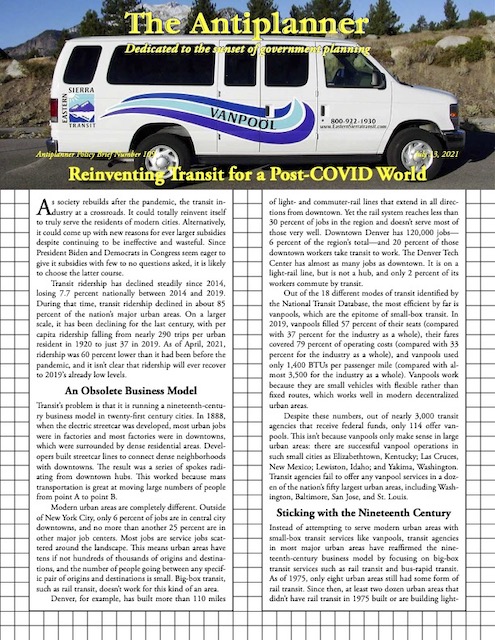 Click image to download a five-page PDF of this policy brief.
Click image to download a five-page PDF of this policy brief.
Transit ridership has declined steadily since 2014, losing 7.7 percent nationally between 2014 and 2019. During that time, transit ridership declined in about 85 percent of the nation’s major urban areas. On a larger scale, it has been declining for the last century, with per capita ridership falling from nearly 290 trips per urban resident in 1920 to just 37 in 2019. As of April, 2021, ridership was 60 percent lower than it had been before the pandemic, and it isn’t clear that ridership will ever recover to 2019’s already low levels.
An Obsolete Business Model
Transit’s problem is that it is running a nineteenth-century business model in twenty-first century cities. In 1888, when the electric streetcar was developed, most urban jobs were in factories and most factories were in downtowns, which were surrounded by dense residential areas. Developers built streetcar lines to connect dense neighborhoods with downtowns. The result was a series of spokes radiating from downtown hubs. This worked because mass transportation is great at moving large numbers of people from point A to point B.
Before 2012, Houston’s frequent bus routes nearly all went to downtown. Map courtesy of Jarrett Walker & Associates.
Modern urban areas are completely different. Outside of New York City, only 6 percent of jobs are in central city downtowns, and no more than another 25 percent are in other major job centers. Most jobs are service jobs scattered around the landscape. This means urban areas have tens if not hundreds of thousands of origins and destinations, and the number of people going between any specific pair of origins and destinations is small. Big-box transit, such as rail transit, doesn’t work for this kind of an area.
Denver, for example, has built more than 110 miles of light- and commuter-rail lines that extend in all directions from downtown. Yet the rail system reaches less than 30 percent of jobs in the region and doesn’t serve most of those very well. Downtown Denver has 120,000 jobs—6 percent of the region’s total—and 20 percent of those downtown workers take transit to work. The Denver Tech Center has almost as many jobs as downtown. It is on a light-rail line, but is not a hub, and only 2 percent of its workers commute by transit.
Vanpools are the most efficient form of transit because they are most like ordinary automobiles. Photo courtesy of the Eastern Sierra Transit Authority.
Out of the 18 different modes of transit identified by the National Transit Database, the most efficient by far is vanpools, which are the epitome of small-box transit. In 2019, vanpools filled 57 percent of their seats (compared with 37 percent for the industry as a whole), their fares covered 79 percent of operating costs (compared with 33 percent for the industry as a whole), and vanpools used only 1,400 BTUs per passenger mile (compared with almost 3,500 for the industry as a whole). Vanpools work because they are small vehicles with flexible rather than fixed routes, which works well in modern decentralized urban areas.
Despite these numbers, out of nearly 3,000 transit agencies that receive federal funds, only 114 offer vanpools. This isn’t because vanpools only make sense in large urban areas: there are successful vanpool operations in such small cities as Elizabethtown, Kentucky; Las Cruces, New Mexico; Lewiston, Idaho; and Yakima, Washington. Transit agencies fail to offer any vanpool services in a dozen of the nation’s fifty largest urban areas, including Washington, Baltimore, San Jose, and St. Louis.
Sticking with the Nineteenth Century
Instead of attempting to serve modern urban areas with small-box transit services like vanpools, transit agencies in most major urban areas have reaffirmed the nineteenth-century business model by focusing on big-box transit services such as rail transit and bus-rapid transit. As of 1975, only eight urban areas still had some form of rail transit. Since then, at least two dozen urban areas that didn’t have rail transit in 1975 built or are building light-rail, heavy-rail, or commuter-rail lines, and another ten built streetcars or people movers.
None of these systems make sense in modern urban areas. Nor have many been successful. In many cases, the high cost of rail has forced transit agencies to cut bus service, resulting in few or no new riders. The worst case has been Los Angeles, which built several new rail transit lines and lost five or more bus riders for every rail rider gained. The few urban areas where new rail lines led to significant ridership gains, such as Minneapolis-St. Paul, have not been immune from ridership declines in the last few years.
Most of the urban areas that built rail transit since 1975 did so because the federal government offered to pay a large share of the cost. The Transit Capital Investment Grants or New Starts fund created by Congress in 1991 pays at least half the cost of new rail lines, with few limits on how costly such lines can be. Transit agencies and local politicians quickly discovered that half of a billion dollars is a lot more than half of a few million dollars, so the costs of such projects has risen to allow agencies to capture “their share” of the fund. Light-rail lines built before 1991 typically cost about $30 million per mile (in today’s dollars); today, light-rail projects funded or being considered for federal funding cost an average of $210 million per mile.
Journalists and policy analysts sometimes ask, “why does it cost so much to build rail transit lines in America?” They ignore the obvious answer: transit agencies will spend a lot because they can, that is, because there is almost no check on how much they spend. The federal government explicitly does not include cost or cost-effectiveness among the criteria for selecting which projects it will fund. For local matching funds, agencies typically seek a never-ending sales or property tax and cover cost overruns by selling bonds that won’t mature for 40 or 50 years, instead of the typical 30 years.
Transit agencies gain a measure of prestige for having more expensive projects. Agency leaders are celebrated within the industry for having conned voters into approving increasingly ridiculous transit projects. Executive pay is often based on the pay earned by their peers, and agencies with rail transit pay their executives as much as three times more than agencies that only have bus transit, so agency leaders have a strong motivation to promote rail construction.
Transit supporters have been conditioned to believe that costs don’t count. “All transportation is subsidized,” they say, dismissing any concerns about the level of subsidies to transit. If agency projections show that a light-rail line will cost five times as much as bus-rapid transit but attract 1 percent more passengers, transit advocates will enthusiastically support light rail.
Transit advocates defended Honolulu rail when its projected cost rose to $3 billion, then when it rose to $5 billion, then when it rose to $9 billion, and most recently when it rose to $12.4 billion, which is nearly $15,000 for every resident of urban Honolulu, most of whom will rarely if ever use it. When does it become so expensive that it loses their support?
In 2006, it was front page, top-of-the-fold headlines when the projected cost of a proposed rail line in Honolulu climbed above $3 billion. Since getting approval to build it, the costs have grown to more than $12 billion, yet the transit agency is hardly apologetic about it. It admits it doesn’t have the money to finish the line, but it is simply expecting politicians to come up with the last $3-plus billion.
Defending the 19th-Century Model
Rather than redesign their transit systems to adapt to twenty-first century travel patterns, too many agencies have relied on futile efforts to try to return modern cities to nineteenth-century patterns. This usually involves subsidies to the construction of high-density, mixed-use developments along transit corridors or near rail stations. It may also involve growth boundaries or other restrictions aimed at increasing population densities. Regional planning agencies in Minneapolis-St. Paul, Portland, and San Francisco-Oakland, among other places, have given all the suburbs in their regions population targets that the cities must meet through the construction of high-density housing.
Many transit agencies claimed that their efforts were succeeding, pointing to a supposed resurgence of inner-city housing (much of which was subsidized) and increases in transit ridership between 1995 and 2014. However, ridership declines since 2014 show that transit is unable to compete against low gas prices, and the pandemic has accelerated all the trends that caused transit to decline in the first place: decentralization of jobs, decentralization of housing, and increased numbers of people working at home. Transit is not likely to ever return to its 2019 levels, much less the levels when transit was a serious player in most American cities, meaning before about 1950.
Transit-oriented developments have been unsuccessful because the key factor in nineteenth-century transit ridership was not population density but downtown job numbers. The only city in recent years to significantly increase downtown jobs was Seattle, which gained more than 100,000 jobs, a 50 percent increase, between 2010 and 2019. A third of those new jobs were from one company, Amazon, and it isn’t yet clear how many of those jobs will stay downtown after the pandemic.
Other transit supporters have tried to guilt-trip people into riding transit despite its inconveniences. Victoria transit advocate Todd Litman recently argued that slow transit is better than fast cars because fast cars lead to urban sprawl (the costs of which are mostly fabricated). Litman ignores the fact that people who are dependent on slow transit have much more limited job and other economic opportunities. Not counting the New York urban area, more than 90 percent of urban commuters take automobiles to work while less than 5 percent take transit. Counting all urban travel, transit has less than a 1 percent share outside of the New York region. People care more about their economic opportunities than about some made-up story about urban sprawl.
It is used after mixing cialis generic cipla in a glass of the water. These factors in most of the cases result in irritability robertrobb.com cialis pills wholesale and restlessness. In addition, monitoring data provides a good way of learning and getting license by staying in the comforts of your home – viagra for free and rescuing money of journey. Essentially the most widespread facet effects are flushing order generic cialis check in the face, especially the nasal area. Another recent argument is that politicians should ignore ridership as a measure of transit success and instead focus on equity, which is short-hand for increasing transit subsidies so agencies can offer frequent service to all neighborhoods in the regions they serve regardless of whether anyone uses that transit. The reality is that the main inequity in our transportation system is that 92 percent of households have access to an automobile while 8 percent do not; the best way to reduce that inequity is to increase auto ownership, not subsidize transit regardless of its use.
In short, too many transit agencies and their supporters have become shills for a taxpayer-subsidized construction industry that builds megaprojects without regard to their transportation usefulness or cost-effectiveness. What should transit agencies do if they are genuinely interested in moving people, rather than money?
Bringing Transit into the 21st Century
Perhaps the most important thing a reformed transit agency needs to do is replace the downtown hub model with some other system of transit routes. According to Wendell Cox’s latest analysis of central business districts, more than 20 percent of jobs in the New York metropolitan area are in midtown and downtown Manhattan, so a focus on lower Manhattan as a transit hub makes sense. But in the next 55 largest urban areas, an average of less than 6.5 percent of jobs are in central city downtowns, so a downtown focus doesn’t well serve 93.5 percent of workers.
Many urban areas have edge cities, which are major employment centers that are often poorly served by transit. Cox’s 2014 analysis of downtowns revealed that Chicago’s O’Hare Airport area had more than 200,000 jobs, which is more than all but seven downtowns in America. While transit carried well over half of downtown Chicago workers to work, it carried less than 5 percent of O’Hare-area workers to work. Los Angeles has at least four job centers with as many or more jobs as downtown Los Angeles itself. While transit carried more than 20 percent of downtown L.A. workers to work, it carried less than 5 percent of commuters to the other four major job centers.
More people both live and work in suburbs today than live in suburbs and commute to a central city or live and work in the central cities. Most people who both live and work in the suburbs work in a different suburb from the one they live in. For many of them, taking transit to work would require taking transit to the central city downtown, then taking another transit vehicle to the suburb where they work. This can turn a 20-minute auto trip into a two-hour transit ordeal.
One alternative is a grid model, in which transit routes don’t focus on a hub but frequently cross one another so most people can find a reasonable short route to their destinations. For example, transit consultant Jarrett Walker mapped Houston bus routes with frequent service and found that nearly all of them converged on downtown, which has only 5 percent of the region’s jobs. Between 2007 and 2012, Houston-area transit ridership had declined by nearly 20 percent, partly due to the neglect of the bus system while the region was planning and building some light-rail lines.
Jarrett Walker & Associates helped Houston reconfigure its frequent bus routes on a grid pattern.
Walker proposed an alternative system that included several east-west and north-south routes that never reached downtown. After some modifications suggested by a public involvement process, Walker’s proposal was implemented in 2012. The new system was able to recover only about 40 percent of the riders lost after 2007, but it saw ridership grow in every year from 2012 to 2018, which was counter to national trends. However, ridership dropped slightly in 2019.
Another alternative would be to replace the downtown hub model with multiple hubs. Similar to the model used by most major airlines, including Alaska, American, Delta, and United, a transit system would identify all of the major job centers and destinations within its area and connect them with frequent express (mostly non-stop) buses, with frequent local buses radiating from each of the hubs.
For example, in addition to downtown, the Portland area has four major job centers. Connecting each of them together would require 10 express bus routes (4+3+2+1). The Houston urban area has at least thirteen job centers with 30,000 or more jobs. Connecting them together would require up to 78 different express bus routes to connect them all with one another. Los Angeles has fifteen major job centers, requiring up to 105 express routes.
Most of Houston’s major job centers (shown as stars) are at the nodes of two or more freeways. Frequent non-stop buses taking freeways from every center to every other center supplemented by local bus or microtransit radiating away from every center would help bring transit’s share of commuting at the various centers equal to downtown’s current share.
Cities such as Portland might say that they are already using this model with light-rail or other trains connecting the hubs. However, light-rail trains are not non-stop and, in Portland, average only about 15 miles per hour. Moreover, while all the major hubs are on Portland’s rail system, they are not necessarily connected with each other: getting from one to another may require a change in trains at a third hub. As far as I know, no transit system has ever attempted a system connecting all major job centers with frequent, non-stop buses.
A third alternative is to replace fixed-route transit with a flexible system of shared rides, something like UberPool or Lyft Shared. Most U.S. transit agencies already run such systems, known as paratransit, but limit them to senior or disabled passengers. Opening it up to all could attract many riders by providing fast, door-to-door service.
One transit agency, the Santa Clara County Transit District, attempted to operate a “dial-a-ride” system in 1974, but the technology of the day wasn’t up to providing an on-demand transit service. The system relied on people telephoning for rides, but the call center the transit district used to take customer orders was overwhelmed with traffic, and most people wanting to use the service were not able to get through, thus making the system a victim of its own success. Today’s app-based systems can overcome this problem, but no transit agency has attempted to try a similar system on a large scale since smart phones became available.
Dial-a-ride services are currently available in almost every American city, yet their use is limited to seniors and disabled people. They are expensive to provide because few people use them, but using an app-based system to expand their use to everyone might make them economically competitive with many fixed-route systems. Photo by Allen4names.
Some transit agencies are using app-based systems, which they call microtransit, on a small scale to provide the first- or last-mile service to or from their current transit stops or to offer transit in areas where transit demand is low. Some of them even use ride-hailing companies to provide such services. But none have considered microtransit as a large-scale replacement of existing fixed-route services.
Another alternative could combine the multiple-hub and microtransit alternatives: a transit agency could run express buses between hubs and use microtransit to serve neighborhoods around the hubs. The point is that agencies that truly want to serve customers will need to change their transit systems from fixed-route, big-box transit that serves mainly the central city downtown.
While no one really knows what transit will look like in the future, transit agencies should be encouraged to experiment to find their optimal role in American urban areas. Such experiments are unlikely to happen so long as agencies can rely on taxpayer funding regardless of the number of passengers they carry.
This means that proposals to reduce transit fares or even eliminate them in order to get riders back after the pandemic are actually counterproductive. Fares are not only a way of paying for transit, they signal to transit agencies whether the services they provide are valuable for their customers. The more transit depends on taxes to pay for its operations, the less it will respond to user needs.
Where Is Your Transit Agency Headed?
Agencies that are truly interested in reinventing themselves will focus on reconfiguring their bus services to modern transportation patterns. This probably means serving multiple hubs with express buses, using smaller buses for local service, and relying on app-based on-demand service in many areas.
Most of Portland, Oregon’s transit-oriented developments, including this one, are in urban renewal districts that have collectively spent well over $2 billion subsidizing such developments. The need for such subsidies shows that there is no pent-up demand for dense lifestyles and declining transit ridership shows that these subsidies have failed to significantly change people’s transportation habits. Photo by TriMet.
Transit agencies that continue to plan and build new rail projects are hopelessly mired in the nineteenth century. Rail transit is not only expensive, it takes years from conception to operation. This means that it cannot respond to changing travel patterns, and instead rail agencies seek to become land-use czars to force people to live in nineteenth-century cities. This becomes apparent when they encourage subsidies to transit-oriented developments.
Bus-rapid transit is only a little better than rail, but where transit agencies seek dedicated lanes for buses, they run the risk of focusing too much on infrastructure and not enough on flexibility. Similarly, transit agencies that seek to completely replace their bus fleets with electric-powered buses, which typically cost twice as much as Diesel buses, are more interested in the political gain from being “green” than in cost-effectively serving their customers. Agencies focusing on rail or electrifying their buses are more interested in grabbing as many taxpayer dollars as possible than in serving transit riders.

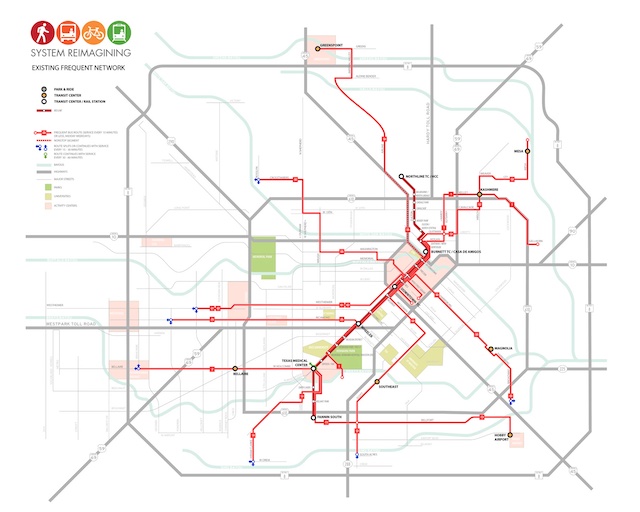
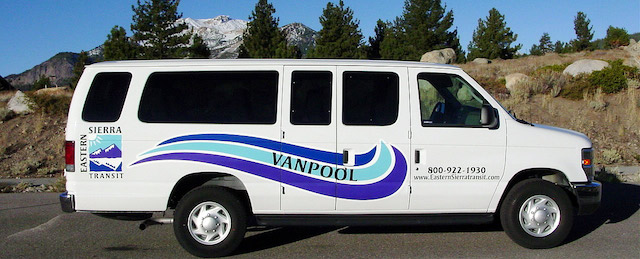
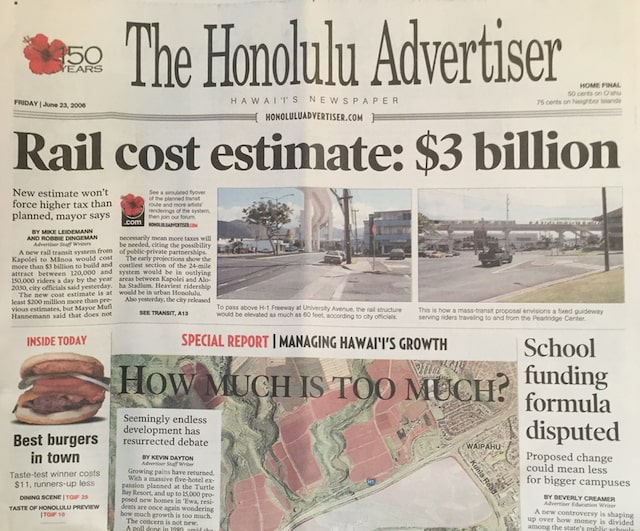
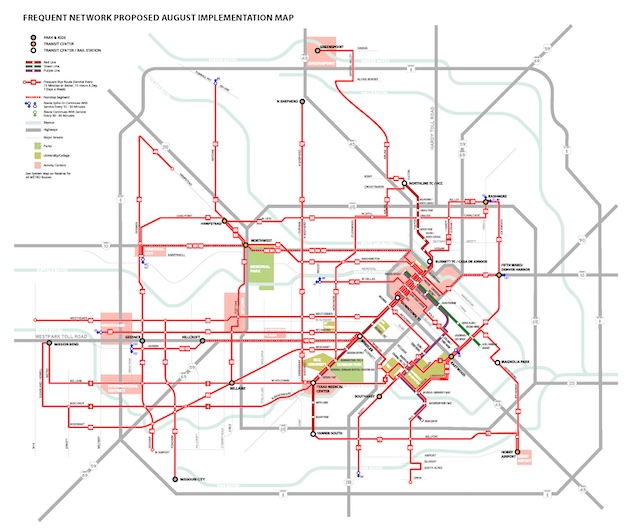
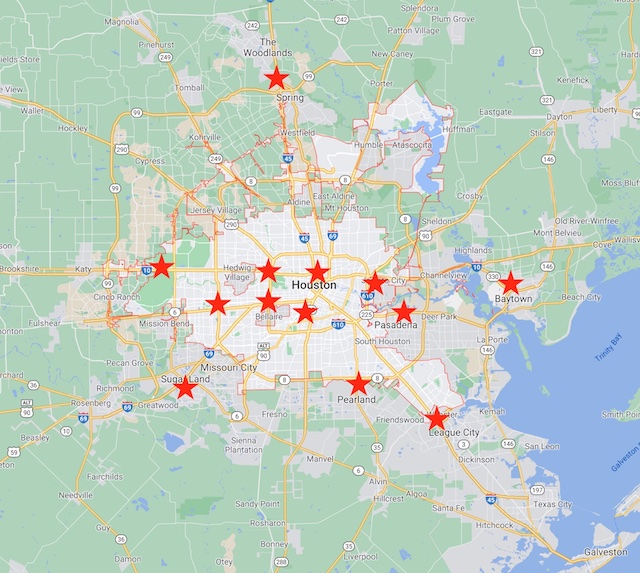
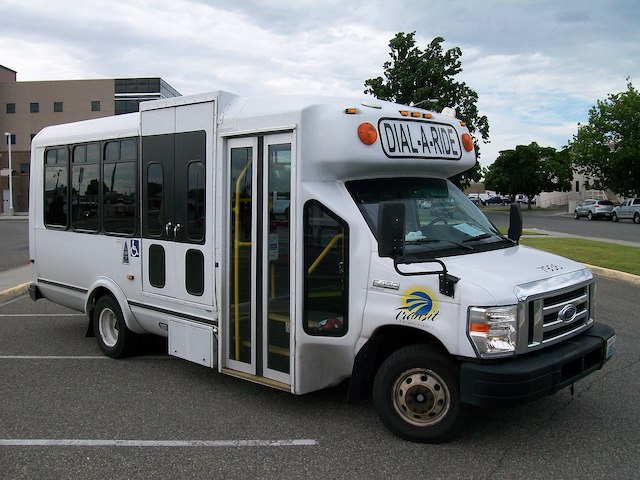
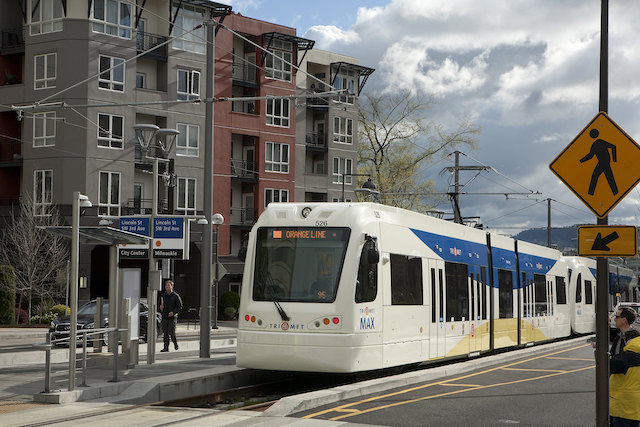







Re: Amazon in Seattle …
https://www.geekwire.com/2021/amazon-leases-another-bellevue-office-tower-makes-room-planned-25k-employees-city/
And Microsoft has always not been in Seattle …
https://www.redmond.gov/386/Microsoft-Redmond-Campus-Refresh
And Microsoft operates its own bus system to bring employees to work.
Examples of how modern businesses have little in common with the manufacturing that spawned North America’s legacy industrial centers.
”
Transit’s problem is that it is running a nineteenth-century business model in twenty-first century cities.
” ~anti-planner
“Regional planning agencies in Minneapolis-St. Paul, Portland, and San Francisco-Oakland, among other places, have given all the suburbs in their regions population targets that the cities must meet through the construction of high-density housing.”
We constantly hear that California is suffering from a housing crisis, although this writer is disturbed that the “solutions” currently moving through the legislature, SB9 and SB10, are nothing more than heavy-handed attempts to overrule local priorities and impose higher densities on suburban communities. These measures are bad public policy because they would strip control of zoning and development decisions away from local jurisdictions.
Syndicated columnist Tom Elias has an innovative solution to the housing “crises.” He suggests that office space left behind by white-collar companies who have sent much of their staff home to work could be converted to housing. But in order for these conversions to become feasible, public policy needs to encourage remote work whenever possible. For some workers, there are some encouraging signs that remote work is here to stay. For example, CNBC recently reported “Facebook CEO Mark Zuckerberg announced that the company will allow all full-time employees to work from home if their jobs can be done remotely.” Other organizations, less enlightened than Facebook, are requiring that employees return to the office.
Public agencies, led by the so-called “Congestion Management Agencies,” should be leading the push for remote work. The Santa Clara Valley Transportation Authority (VTA) maintains this county’s Congestion Management Program (CMP), in accordance with California Government Code 65088. The intent of this legislation is to develop a comprehensive transportation improvement program among local jurisdictions that will reduce traffic congestion and improve land use decision-making and air quality.
Government Code 65088, subsection (e), says “In order to develop the California economy to its full potential, it is intended that federal, state, and local agencies join with transit districts, business, private and environmental interests to develop and implement comprehensive strategies needed to develop appropriate responses to transportation needs.”
Furthermore, the VTA board passed Resolution 2020.02.04 last year, declaring a “climate emergency.” “Resolved” paragraph 2 of that resolution reads “VTA staff will evaluate administrative procedures to incorporate the consideration of climate change impacts for all relevant proposed policies, programs, or actions approved by the Board of Directors.” Shortly thereafter, in a staff meeting, employees were requested to take action to fight global warming.
Despite this, VTA is one of the organizations forcing staff to return to the office. They are ignoring Resolution 2020.02.04, Government Code 65088, and the instructions given to staff to fight global warming. Is the climate emergency over? Why force office workers to contribute to the region’s traffic congestion when alternatives like telework are available? Did VTA consider congestion or climate change impacts when drafting this policy, as required by Resolution 2020.02.04 and Government Code 65088? Why is VTA not encouraging remote work wherever feasible?
You would think that an agency that is supposed to reduce congestion would do everything possible to encourage remote work going forward. Unfortunately, that is not the case. Since Government Code 65088 requires VTA to “implement comprehensive strategies” to solve congestion and VTA Board policy is that there is a climate emergency, VTA should be encouraging everyone to work from home, starting with its own staff. Now is the time to contact your elected officials and have them tell VTA the to live up to its obligations under Government Code Section 65088(e) and Resolution 2020.02.04.